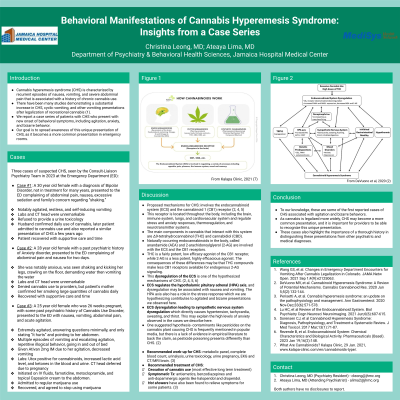Substance Use and Related Disorders
(165) Behavioral Manifestations of Cannabis Hyperemesis Syndrome: Insights from a Case Series

- CL
Christina Leong, MD (she/her/hers)
Psychiatry Resident
Jamaica Hospital Medical Center
Rego Park, New York .jpg)
Ateaya Lima, MD
Director of Consultation-Liaison Psychiatry
None
Queens, New York
Presenting Author(s)
Co-Author(s)
Background: Cannabis hyperemesis syndrome (CHS) is characterized by episodes of nausea and vomiting, associated with a history of chronic cannabis use. There have been many studies demonstrating a substantial increase in CHS, cyclic vomiting, and vomiting presentations after legalization of recreational cannabis (1). We report a case series of patients with CHS who present with new onset of behavioral symptoms, including agitation, anxiety, and bizarre behavior.
Cases: A series of 2 cases of suspected CHS, seen by the Consult-Liaison Psychiatry Team in 2023 at the Emergency Department (ED) is reported. The first case is of a 30 year old female with a diagnosis of Bipolar Disorder, not in treatment for many years, who presented to the ED complaining of abdominal pain, nausea, excessive sedation and family’s concern regarding “shaking.” On evaluation, patient was notably agitated, and was observed by staff to be restless, and self-inducing vomiting. Labs and CT head were unremarkable. She refused to provide a urine toxicology sample, but husband confirmed daily use of cannabis. The second case is of a 28 year old female with a past psychiatric history of Anxiety disorder, who presented to the ED complaining of abdominal pain and nausea for two days. Upon evaluation, she was notably anxious, was seen shaking and kicking her legs, crawling on the floor, demanding water then vomiting the water. She denied cannabis use to providers, but patient's mother confirmed her smoking large quantities of cannabis daily. Both patients recovered with supportive care and time and ultimately admitted to daily use of cannabis.
Discussion: With CHS becoming a more common presentation in the ED, these two cases highlight how this syndrome can present with unique behavioral symptoms. A possible mechanism of this presentation may involve the endocannabinoid system, as D9-tetrahydrocannabinol (THC) acts on the cannabinoid 1 (CB1) receptor, and results in dysregulated stress and anxiety responses, thermoregulation, and neurotransmitter systems (2). For the treatment of CHS, the most effective long-term treatment is cessation of cannabis use, and it can acutely be managed by antiemetics, benzodiazepines and anti-dopaminergic agents like haloperidol and droperidol (3).
Conclusions: To our knowledge, these are some of the first reported cases of CHS associated with agitated and bizarre behaviors. As cannabis is legalized more widely, CHS may become a more common presentation, and it is important for providers to be able to recognize unique presentations. These cases also highlight the importance of a thorough history in distinguishing these presentations from other psychiatric diagnoses.
References:
1. Wang GS, Buttorff C, Wilks A, Schwam D, Tung G, Pacula RL. Changes in Emergency Department Encounters for Vomiting After Cannabis Legalization in Colorado. JAMA Netw Open. 2021 Sep 1;4(9):e2125063.
2. DeVuono MV, Parker LA. Cannabinoid Hyperemesis Syndrome: A Review of Potential Mechanisms. Cannabis Cannabinoid Res. 2020 Jun 5;5(2):132-144.
3. Perisetti A, Gajendran M, Dasari CS, Bansal P, Aziz M, Inamdar S, Tharian B, Goyal H. Cannabis hyperemesis syndrome: an update on the pathophysiology and management. Ann Gastroenterol. 2020 Nov-Dec;33(6):571-578.
Presentation Eligibility: Not previously published or presented
Diversity, Equity, and Inclusion: Cannabis hyperemesis syndrome (CHS) presentations have been increasing with the increasing rates of legalization and chronic cannabis use. In a study by Jeffers et al., it was seen nationally that high frequency cannabis use is more common in racial minorities. Because of this, CHS may be a more common presentation for racial minorities.
Reference:
Jeffers AM, Glantz S, Byers A, Keyhani S. Sociodemographic Characteristics Associated With and Prevalence and Frequency of Cannabis Use Among Adults in the US. JAMA Netw Open. 2021 Nov 1;4(11):e2136571.

